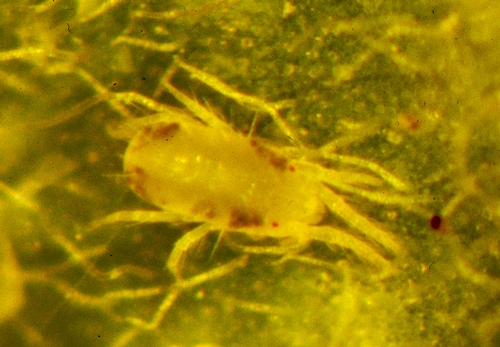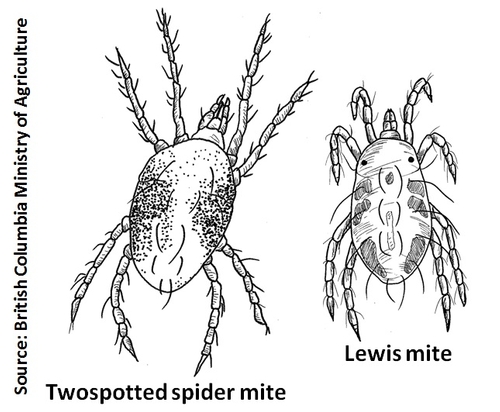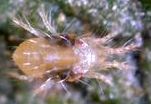
Lewis mite, Eotetranychus lewisi (Photo courtesy: Daniel Gilrein, Cornell University)
Lewis spider mite or Lewis mite, Eotetranychus lewisi (McGregor) (Phylum Arachnida, sub-class Acarina, family Tetranychidae) is a pest of many host plants. In the US, it has been reported on citrus and greenhouse poinsettias. Lewis mites have been seen on strawberries and raspberries in the Ventura area for some time, but growers appear to be noticing increased infestations in the recent years. Some growers have also seen them in Santa Maria in the recent years, but they have so far not been reported from the Watsonville area. Considering the recent trend, growers might keep them in mind while scouting for pests. Environment, natural enemies, cropping patterns, pesticide usage and other agronomic practices are among the factors that influence the status of pests. It is not yet clear why infestations are increasing, but here is some information on Lewis mite.
Host range and distribution: According to an earlier report (Bolland et al, 1998), Lewis mite is distributed mostly in the western hemisphere and some parts of Africa infesting 65 species of plants including food and multipurpose plants like Erythrinia edulis, Citrus spp., Prunus sp., papaya, fig, ornamentals like Cleome sp., Bauhinia spp., Rosa sp., Euphorbia spp. (poinsettia, snow-on-the-mountain, fire-on-the-mountain), weeds like silverleaf nightshade, and various other hosts. It has later spread to parts of Europe and East Asia. Lewis mite infestation on strawberries was reported from Philippines nearly a decade ago (Raros, 2001).
Biology: Males are about 0.25 mm and females are about 0.36 mm long. Species identification is tricky and requires both sexes to be examined microscopically. They can be confused with twospotted spider mite (TSSM), Tetranychus urticae in their general appearance. But, comparing adult females, Lewis mites are smaller than TSSM and have several small spots on their body while TSSM have a single dark spot on either side of the body. Lewis mite has five life stages – egg, larva, protonymph, deutonymph and adult. Eggs are round, whitish to light orange. Females lay 60-90 eggs over a period of about a month. It takes about 12-14 days from egg to adult stage at 21oC (70oF).


Twospotted spider mite (right, UC IPM)
Damage: Symptoms of damage vary according to the host plant. On poinsettia, Lewis mite feeds on the underside of the leaves and causes very fine stippling or flecking on foliage, which can be initially mistaken for nutrient deficiency. Infestations can build to high levels in poinsettia before mites and their webbing are noticed. Since their infestation in strawberries currently coincides with TSSM infestations, exclusive Lewis mite damage symptoms in strawberries are yet to be determined. In some hosts like papaya, damage resembles symptoms of viral infection and may cause distortion and yellowing of young leaves. According to Daniel Gilrein, an extension entomologist from Cornell University, fine flecking from Lewis mite feeding almost resembles nitrogen deficiency and can delay detection until populations build up. Leaves turn brown and webbing can be seen as the damage advances.
Management: In research on greenhouse poinsettias (D. Gilrein, pers. comm.), abamectin (Avid for ornamentals, Agri-Mek and generics for food crops), acequinocyl (Kanemite and Shuttle-O), bifenazate (Acramite and Floramite), fenpyroximate (Akari and Fujimite), spiromesifen (Judo and Oberon) were found effective in controlling Lewis mite. These are also among the miticides recommended by UC IPM for spider mites on strawberries. However, there have been some suspected resistance issues in some populations of Lewis mite in strawberry growing areas of California, but some of these materials act primarily as contact miticides and issues of coverage cannot be ruled out in all cases.
What to do: Look for Lewis mites while scouting for TSSM especially in fields close to infested ornamentals. Keep in mind that there could be resistance or efficacy problems with some miticides in certain areas with TSSM or Lewis mites. It is always a good practice to rotate miticides with different modes of action for better management and reducing the risk of resistance development. The mode of action is indicated on most lables (e.g. Agri-Mek is a Group 6 Insecticide) If you suspect resistance in TSSM or Lewispopulations in your area, perform a simple test to evaluate the effectiveness of the intended miticides. Dip several mite-infested leaves in a cup of miticide solution (concentration similar to the field application rate), let them dry and then cover (to keep foliage from drying out completely) and place in a cool area away from direct sun. Check to see if any mites have survived 24 and 48 hours after dipping. The effectiveness of the miticide will be indicated by the number of mites alive or dead. For comparison, dip several similar mite-infested leaves in normal water and treat similarly, observing the survival of mites on those leaves as well. This can be a useful comparison for new, untested miticides as well as for older products where miticide resistance is suspected.
UC researchers are working on this issue and will have some more information in the near future. If you suspect or find Lewis mites in your fields, please contact me at skdara@ucdavis.edu or 805-788-2321.
http://ucanr.edu/articlefeedback
References
Bolland H. R., J. Gutierrez and C.H.W. Fletchtmann. 1998. World Catalogue of the Spider Mite Family (Acari: Tetranychidae.) Brill, Leiden (NL).
Gilrein, D. 2011. Cornell Cooperative Extension of Suffolk County, LIHREC, Riverhead, NY.
Raros, L.A.C. 2001. New mite pests and new host records of phytophagous mites (Acari) from the Philippines. Philippine Agricultural Scientist 84: 341-351.
